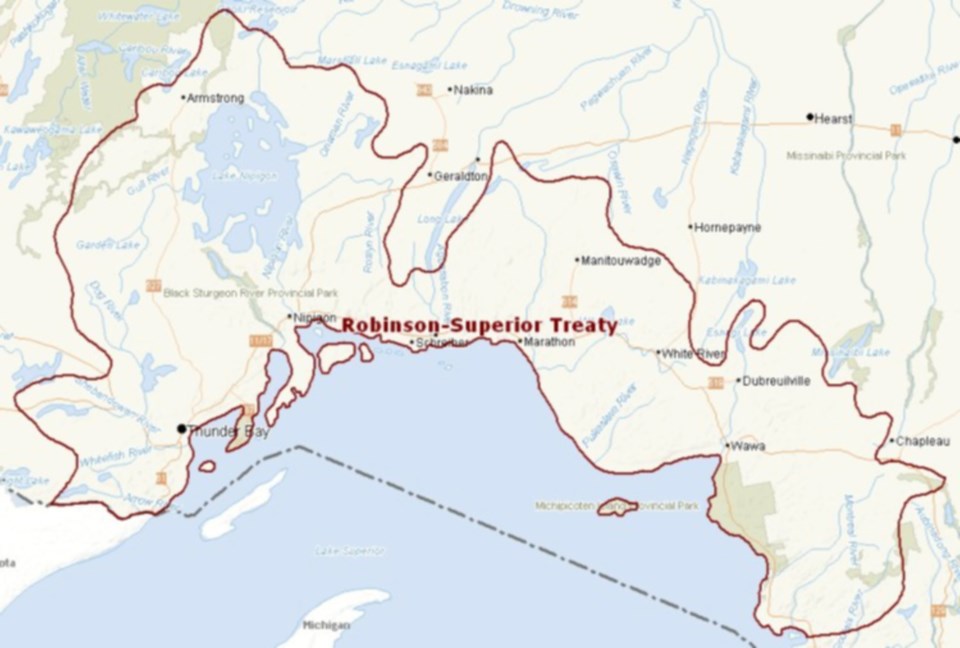An expert witness in the Robinson Superior Treaty annuities trial is being called into question over the timeline in which one of his evidentiary reports was authored and the extent of Ontario’s involvement in putting the report together.
Dr. Alexander von Gernet — a semi-retired anthropologist and ethnohistorian who has testified numerous times for the Crown in Indigenous rights and land claim disputes — took the stand in a Sudbury, Ont. courtroom Monday, where he was bombarded with questions from both legal counsel for Robinson Superior Treaty (RST) First Nations and Ontario Superior Court Justice Patricia Hennessy around how the expert witness managed to construct his report on the Crown’s attempts to pay for treaty annuities beginning in 2020 when he didn’t receive his actual ‘letter of instruction’ from Ontario until June 2022 — three months before the report was completed.
After the first two stages of the Robinson Superior trial, Hennessy ruled that the federal and Ontario governments had to pay an increased annuity that reflected a “fair share,” so long as there were enough resource-based revenues to do so without incurring a loss. She also made this ruling in regards to the Robinson Huron Treaty annuities case.
In both, the province’s Court of Appeal mostly upheld those decisions. But while the federal government let both rulings stand, the Province of Ontario is taking the decisions to the Supreme Court of Canada.
Earlier this year, Canada and Ontario entered into settlement talks with one of the treaty groups — Robinson Huron, but not Robinson Superior.
Both communities are in court seeking billions of dollars in compensation after almost 150 years of receiving small annual payments in return for ceding much of Northern Ontario to the Crown. But the provincial government is arguing they are owed nothing, or at most $34 million.
The third stage of the Robinson Superior annuities trial will determine the amount of compensation, and which levels of governent are responsible to pay the increased treaty annuities.
During Monday's testimony, von Gernet told the court he began work on his report on annuity payments sometime in 2020, but had been retained previously to research the boundaries of the Robinson Huron Treaty and the mapping of the treaty territory.
Somewhere along the line, he said, Ontario asked him to look into the entire history of the Crown paying annuities in Robinson Superior Treaty territory.
Harley Schachter, legal counsel representing Whitesand and Red Rock First Nations, was skeptical right off the bat.
“You weren’t asked any questions, you just came up with the idea yourself?” Schachter asked von Gernet.
In his response, von Gernet told the court he was asked verbally if he could start compiling all of the documentation on Crown conduct in relation to the aftermath of the two Robinson treaties and the payment of treaty annuities.
Other than that, he said, there had been just one actual ‘letter of instruction’ from the province, dated June 2, 2022. The letter alluded to a number of projects, the most important one being the Robinson Huron Treaty “boundaries issue.” His final report would be submitted that September.
Schachter would go a step further, alleging that von Gernet had engaged in “numerous discussions” with Ontario legal counsel where the parties discussed what the letter of instruction would ultimately say.
“Where are we going with this?” said someone in the courtroom, presumably one of the lawyers for Ontario. “Is this relevant?”
Schachter countered, asserting that it wasn’t an “unfair question” to “find out what the instructions were and how they came into existence.”
“It is my view that this line of questioning is completely relevant,” Hennessy chimed in, adding that the letters of instruction have come up in the questioning of “every single witness.”
“I am not finding it easy to understand how this witness proceeded with these enormous reports on the basis of a single letter from [Ontario] that was not primarily about history, but about boundaries — and the only letter of instruction is three months before a voluminous, heavily-researched report,” Hennessy continued. “I find it troublesome, and I think this matter is completely relevant.”
Prior to the exchange, Schachter pointed out to the court that von Gernet had testified 36 times — many of those times for federal and provincial levels of government in Indigenous rights and land claim court cases, as revealed in testimony last week — between 1993 and 2021. It was also noted that his last field work and peer-reviewed publication, the court heard, both happened in 1996.
According to last week's hearings, von Gernet had previously testified in the first stage of the annuities trial, which included both Robinson Superior Treaty and Robinson Huron Treaty (RHT).
The RHT proceedings adjourned this past January for confidential settlement negotiations between RHT representatives, Canada and Ontario.
Cross-examination of von Gernet’s reports is expected to continue throughout the week.
